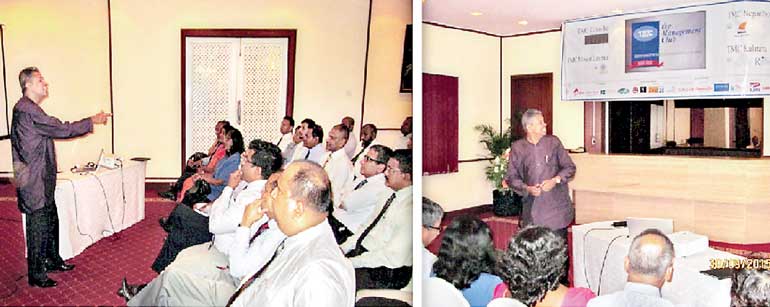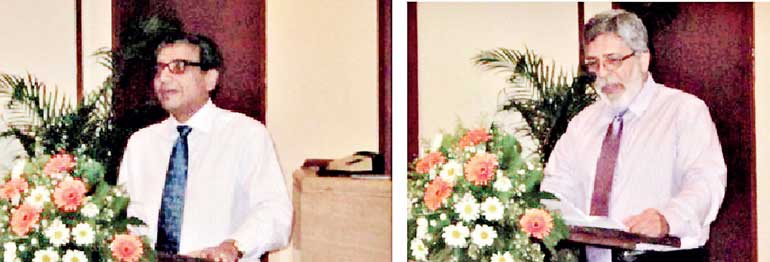Tuesday Mar 18, 2025
Tuesday Mar 18, 2025
Monday, 5 October 2015 00:00 - - {{hitsCtrl.values.hits}}



Professor Ajantha Dharmasiri in spite of his very busy schedule and his impending overseas visit the next day – 1 October, had agreed to a request from his old friend – President Emeritus of the Management Club – Fayaz Saleem to make a very useful, interesting and informative presentation on a topic that most top managements in organisations need to be aware of i.e. ‘Engaging Employees for Enterprise Excellence’.
Prof. Dharmasiri, a doyen in the field of HR Studies first commenced with a Bsc Engineering Degree, becoming a Chartered Engineer, accepted as a Member of the CMI UK, then obtained his MBA and he went further to obtain his PHD and thereafter winning the Platinum Award presented by the Alumni of the Post Graduate Institute of Management for his outstanding academic contribution, shared with a packed audience of around 50 participants in the VIP Room at Galadari Hotel on the subject of Employee Engagement .
His presentation was lively, interactive, interspersed with interesting examples he used, in many aspects of employee engagement. The feedback from many participants was that it was a very interesting presentation mixed with examples, theoretical situations and humour.
He commenced the presentation stating that ‘Employees are our most valuable asset’; this he said had become a hacked statement that appears in almost all corporate reports. It is easier to say than done. However, he also stated that not all employees are assets, some are liabilities for sure. Yet one fact is quite clear, engaged employees achieve excellent results.
Employee engagement has become a buzz word in the management circle mainly due to its attractiveness, as a tool in getting work done. He asked this question as to what we mean by ‘Employee Engagement’? He said interestingly it means different things to different people. Quoting from the research carried out by Macey and Schneider, the meaning of Employee Engagement is ambiguous amongst academic, researchers and among practitioners. He also stated that it captures the essence of employees ‘head, hands and heart’ involved in work. He also said it refers to the employee’s psychological state – e.g. one’s identification with the organisation, his/her disposition, e.g. one’s positive feeling towards the organisation, and performance, e.g. one’s level of discretionary effort. In brief it captures effective (feeling), cognitive (thinking) and behavioural (acting) dimensions of an employee.
The presentation was very important as the topic was so relevant to all those who participated who needed to understand the importance of employee engagement to get better results.
Quoting Richard Branson, Prof Ajantha said, “Clients do not come first; employees come first. If you take care of your employees, they will take care of the clients.”
Discover Kapruka, the leading online shopping platform in Sri Lanka, where you can conveniently send Gifts and Flowers to your loved ones for any event including Valentine ’s Day. Explore a wide range of popular Shopping Categories on Kapruka, including Toys, Groceries, Electronics, Birthday Cakes, Fruits, Chocolates, Flower Bouquets, Clothing, Watches, Lingerie, Gift Sets and Jewellery. Also if you’re interested in selling with Kapruka, Partner Central by Kapruka is the best solution to start with. Moreover, through Kapruka Global Shop, you can also enjoy the convenience of purchasing products from renowned platforms like Amazon and eBay and have them delivered to Sri Lanka.
Discover Kapruka, the leading online shopping platform in Sri Lanka, where you can conveniently send Gifts and Flowers to your loved ones for any event including Valentine ’s Day. Explore a wide range of popular Shopping Categories on Kapruka, including Toys, Groceries, Electronics, Birthday Cakes, Fruits, Chocolates, Flower Bouquets, Clothing, Watches, Lingerie, Gift Sets and Jewellery. Also if you’re interested in selling with Kapruka, Partner Central by Kapruka is the best solution to start with. Moreover, through Kapruka Global Shop, you can also enjoy the convenience of purchasing products from renowned platforms like Amazon and eBay and have them delivered to Sri Lanka.